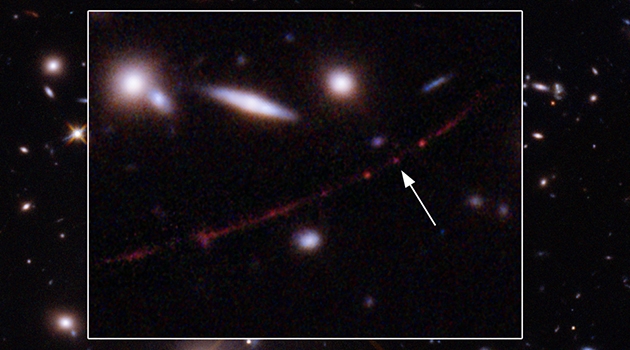Star discovered 28 billion light-years away
As part of an international collaboration, researchers at Uppsala University have succeeded in resolving what appears to be an individual star whose light was emitted from a region in space that is currently 28 billion light-years away from us. This is a new distance record for observations of individual stars from the early Universe. The observations were made with the aid of the Hubble Telescope and the results have been published in Nature.
The new discovery breaks all previous records for identifying individual stars from the early Universe. This star just observed originates from a time only 900 million years after the Big Bang – a time when the Universe was only 7 per cent of its current age.
So far, it has been very difficult to gain much insight into the Universe’s early development and only the biggest and most brilliant objects shine so brightly in the night sky that they can be observed at this distance. Even the combined light from entire galaxies consisting of many millions of stars can often be difficult to pick out at these extreme distances.
The star, which has been nicknamed Earendel, was discovered using the Hubble Telescope in the course of observations of the galaxy cluster named WHL 0137-08. Earendel could be observed because it is located in a strong gravitationally lensed field where the flux from the star was magnified significantly
Gravitational lens
The phenomenon of a gravitational lens occurs when the gravitational pull from dense galaxy clusters causes the light from more distant objects to be bent and magnified. This is comparable to a giant magnifying glass sweeping over the field of view which, when the focus is in just the right place, can cause the light from an individual star to be sufficiently magnified that it becomes visible with, in this case, the Hubble Telescope.
The effects of gravitational lensing mean that what we see in the night sky is a slightly inaccurate picture of the objects from which the light derives. The extreme gravitational pull of giant clusters of galaxies, gas, stars, black holes and dark matter can bend and distort the light visible in the telescope. Galaxies that would otherwise be perceived as faint dots in the field of view can instead be distorted into bright, elongated arcs in which smaller structures, such as stars, are revealed. By studying the light from galaxy WHL 0137-zD, which was the source of the gravitational lensing, the research team succeeded in distinguishing the star they called Earendel, whose light is magnified by a factor of several thousand.
of Physics and Astronomy.
“This is a very unusual event that provides us with a unique opportunity to study a star in greater detail from the Universe’s earliest period,” explains Anton Vikaeus, doctoral student at Uppsala University’s Department of Physics and Astronomy.
When studying the Universe, we often see only still images of the objects that once emitted the light. Earendel, whose light has now travelled 12.9 billion years through the Universe, lived for only a few million years before exploding in a powerful supernova. The remnants of the star are now parts of other stars that formed at a later stage. It is also highly probable that the core of the star collapsed during the explosion to form a black hole that still exists today.
Observation time with new space telescope
The research group was recently allocated some observation time with the James Webb telescope, through which they will be able to study Earendel to further investigate the exact origin and nature of the star.
At such extreme distances and early periods in the history of the Universe, there are excellent prospects of discovering first-generation stars, which consisted only of hydrogen, helium and extremely small amounts of lithium, and formed shortly after the Big Bang. It remains to be seen whether Earendel is actually a first-generation star. If so, many more interesting scientific discoveries are in store.
The study was carried out as part of an international collaboration, with Swedish contributions from Erik Zackrisson and Anton Vikaeus at Uppsala University.

